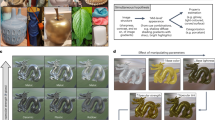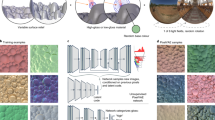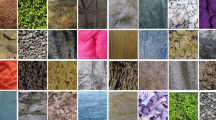Abstract
Our visual system relies on the image structure generated by the interaction of light with objects to infer their material properties. One widely studied surface property is gloss, which can provide information that an object is smooth, shiny or wet. Studies have historically focused on the role of specular highlights in modulating perceived gloss. Here we show in human observers that glossy surfaces can generate both bright specular highlights and dark specular 'lowlights', and that the presence of either is sufficient to generate compelling percepts of gloss. We show that perceived gloss declines when the image structure generated by specular lowlights is blurred or misaligned with surrounding surface shading and that perceived gloss can arise from the presence of lowlights in surface regions isolated from highlights. These results suggest that the image structure generated by specular highlights and lowlights is used to construct our experience of surface gloss.
This is a preview of subscription content, access via your institution
Access options
Subscribe to this journal
Receive 12 print issues and online access
$209.00 per year
only $17.42 per issue
Buy this article
- Purchase on Springer Link
- Instant access to full article PDF
Prices may be subject to local taxes which are calculated during checkout






Similar content being viewed by others
References
Beck, J. & Prazdny, K. Highlights and the perception of glossiness. Percept. Psychophys. 30, 407–410 (1981).
Blake, A. & Bülthoff, H. Does the brain know the physics of specular reflection? Nature 343, 165–168 (1990).
Wendt, G., Faul, F. & Mausfeld, R. Highlight disparity contributes to the authenticity and strength of perceived glossiness. J. Vis. 8, 14 (2008).
Todd, J.T., Norman, J.F. & Mingolla, E. Lightness constancy in the presence of specular highlights. Psychol. Sci. 15, 33–39 (2004).
Anderson, B.L. & Kim, J. Image statistics do not explain the perception of gloss and lightness. J. Vis. 9, 10 (2009).
Kim, J., Marlow, P. & Anderson, B. The perception of gloss depends on highlight congruence with surface shading. J. Vis. 11, 4 (2011).
Marlow, P., Kim, J. & Anderson, B. The role of brightness and orientation congruence in the perception of surface gloss. J. Vis. 11, 16 (2011).
Pellacini, F., Ferwerda, J.A. & Greenberg, D.P. Toward a psychophysically-based light reflection model for image synthesis. Proc. SIGGRAPH 55–64 (2000).
Fleming, R.W., Dror, R.O. & Adelson, E.H. Real-world illumination and the perception of surface reflectance properties. J. Vis. 3, 347–368 (2003).
Fleming, R.W., Torralba, A. & Adelson, E.H. Specular reflections and the perception of shape. J. Vis. 4, 798–820 (2004).
Doerschner, K., Maloney, L.T. & Boyaci, H. Perceived glossiness in high dynamic range scenes. J. Vis. 10, 11 (2010).
Olkkonen, M. & Brainard, D.H. Perceived glossiness and lightness under real-world illumination. J. Vis. 10, 5 (2010).
Hunter, R.S. & Harold, R.W. The Measurement of Appearance 2nd edn. (New York, Wiley, 1987).
Ferwerda, J.A., Pellacini, F. & Greenberg, D.P. A psychophysically–based model of surface gloss perception. Proc. SPIE Human Vis. Electronic Imaging 4299, 291–301 (2001).
Koenderink, J.J. & van Doorn, A.J. Photometric invariants related to solid shape. Opt. Acta 27, 981–996 (1980).
Klinker, G.J., Shafer, S.A. & Kanade, T. The measurement of highlights in color images. Int. J. Comput. Vis. 2, 7–32 (1988).
Wendt, G., Faul, F., Ekroll, V. & Mausfeld, R. Disparity, motion, and color information improve gloss constancy performance. J. Vis. 10, 7 (2010).
Motoyoshi, I., Nishida, S., Sharan, L. & Adelson, E.H. Image statistics and the perception of surface qualities. Nature 447, 206–209 (2007).
Kim, J. & Anderson, B. Image statistics and the perception of surface gloss and lightness. J. Vis. 10, 3 (2010).
Wijntjes, M.W.A. & Pont, S.C. Illusory gloss on Lambertian surfaces. J. Vis. 10, 13 (2010).
Ward, G.J. The RADIANCE lighting simulation and rendering system. Proc. SIGGRAPH 28, 459–472 (1994).
Debevec, P. Image-based lighting. IEEE Comput. Graph. Appl. 22, 26–34 (2002).
Cook, R.L. & Torrance, K.E. A reflectance model for computer graphics. Proc. SIGGRAPH 15, 307–316 (1981).
Acknowledgements
We thank M. Niemela for 3D printing of physical surface models, R. Fleming for advice on rendering techniques, K. Grady for artistic inspiration, and an anonymous reviewer for insight about the optics of paints. This project was funded by an Australian Research Council Discovery Project awarded to B.L.A., J.K. and R. Fleming, and an Australian Research Council fellowship to B.L.A.
Author information
Authors and Affiliations
Contributions
J.K. created the initial demonstration of specular lowlights. J.K., P.J.M. and B.L.A. designed the experiments and visual stimuli. J.K. rendered the images, collected the data and performed the statistical analyses. J.K., P.J.M. and B.L.A. interpreted the results and wrote the paper.
Corresponding authors
Ethics declarations
Competing interests
The authors declare no competing financial interests.
Supplementary information
Supplementary Text and Figures
Supplementary Figures 1–2 (PDF 852 kb)
Rights and permissions
About this article
Cite this article
Kim, J., Marlow, P. & Anderson, B. The dark side of gloss. Nat Neurosci 15, 1590–1595 (2012). https://doi.org/10.1038/nn.3221
Received:
Accepted:
Published:
Issue Date:
DOI: https://doi.org/10.1038/nn.3221
This article is cited by
-
Material category of visual objects computed from specular image structure
Nature Human Behaviour (2023)
-
Development of an image-based measurement instrument for gloss characterization
Journal of Coatings Technology and Research (2022)
-
Human brain activity reflecting facial attractiveness from skin reflection
Scientific Reports (2021)
-
The effect of geometry and illumination on appearance perception of different material categories
The Visual Computer (2021)
-
Image deformation as a cue to material category judgment
Scientific Reports (2017)



